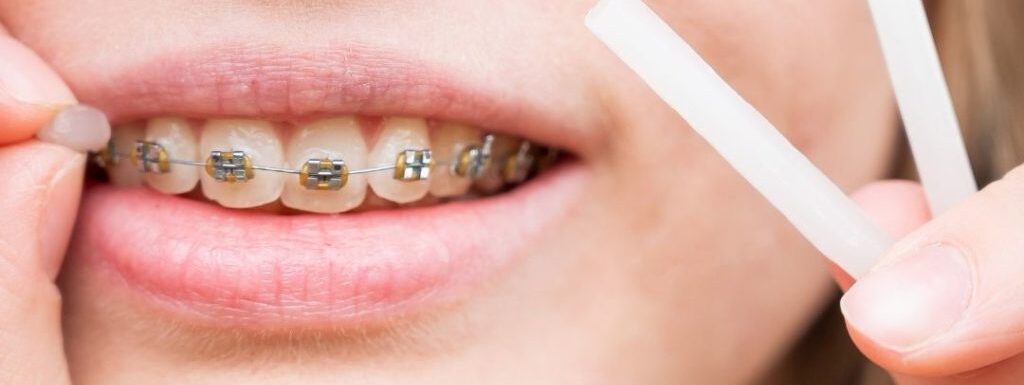Many people who get braces for the first time wonder if they can sleep with wax on their braces.
Wax is often recommended by orthodontists to help alleviate discomfort and prevent irritation, especially after adjustments or when a wire is poking the soft tissues of the mouth.
This article will explore whether it is safe to sleep with wax on your braces and if there are any precautions you should take.
It’s important to highlight that it is indeed safe to sleep with wax on your braces. The wax serves as a protective barrier, making the braces more comfortable and reducing the chances of cuts and sores in the mouth.
While sleeping with wax on braces is safe and recommended, it is crucial to maintain proper oral hygiene and wax replacement.
Replacing the wax two to three times a day is beneficial, as a single piece won’t last long on the braces, ensuring that the wax functions effectively.
Understanding Dental Wax
Dental wax is a soft substance designed for use with orthodontic braces.
It helps to alleviate discomfort and protect the mouth from irritation caused by brackets or wires.
In this section, we will discuss the purpose of dental wax and how to apply it.
Purpose of Dental Wax
Dental wax serves a few purposes when used with braces:
- It provides a protective barrier between the braces and the soft tissues of the mouth, preventing cuts and sores.
- By reducing irritation, dental wax can make the braces feel more comfortable, especially when they are first applied or adjusted.
- It can help relieve pain and discomfort caused by brackets and wires that may have sharp or rough edges.
Orthodontic wax is non-toxic and safe to sleep with, ensuring comfort even during the night.
How to Apply Dental Wax
Applying dental wax to your braces is a simple process. Be sure to follow these steps:
- Wash your hands thoroughly to ensure they are clean before touching the wax and your mouth.
- Cut or pinch off a small, pea-sized piece of dental wax from the block or strip provided.
- Roll the wax between your fingers to gently warm it up, making it easier to mold and apply to your braces.
- Press the softened wax onto the bracket or wire causing irritation, making sure it covers the entire area that’s causing discomfort. Ensure the wax creates a smooth surface, free of rough or sharp edges. You can add a little more wax if necessary.
Remember, you can sleep with dental wax on your braces, as it poses no harm and can help provide a more comfortable night’s rest.
Sleeping with Wax on Braces
Many people wonder if they can sleep with wax on their braces. In general, the answer is yes. Wax can provide comfort and protection to the mouth while a person rests.
In this section, we will discuss the advantages and disadvantages of sleeping with wax on braces.
Advantages of Sleeping with Wax
Sleeping with wax on braces offers numerous benefits:
- Comfort: Braces can cause discomfort due to the brackets and wires rubbing against the cheeks and gum. Wax creates a barrier and reduces friction, leading to a more comfortable night’s sleep.
- Protection: The wax can prevent cuts and sores that may develop due to contact between the braces and the soft tissues of the mouth.
- Adjustment: During the initial period of wearing braces, patients may experience soreness and irritation. Using wax while sleeping can help with adjusting to the braces faster.
Possible Disadvantages
While sleeping with wax on braces is generally safe, there are some possible downsides to consider:
- Temporary solution: Although wax can provide relief, it is not a permanent solution to discomfort. It is essential to check with the orthodontist if persistent discomfort is experienced.
In summary, sleeping with wax on braces can be beneficial for those experiencing discomfort or irritation caused by braces.
However, it may not be the best long-term solution for everyone, and it is necessary to consult an orthodontist for ongoing issues.
Conclusion
In summary, it is perfectly safe to sleep with wax on your braces. Using dental wax overnight can help provide comfort and maintain the braces’ proper placement. Just remember to choose high-quality wax and not to leave it on for more than 24 hours.
Applying dental wax is easy – ensure that your hands and teeth are clean, and gently press a small piece of wax onto the braces’ area that requires cushioning. This small additional step in your nighttime routine can make a significant difference in your overall braces-wearing experience, letting you sleep comfortably and worry-free.
While dental wax is an excellent solution for braces-related discomfort, always consult your orthodontist if you experience severe or lasting pain, as this might indicate a more significant issue. Good communication with your orthodontist can ensure the best possible outcome for your dental journey.

